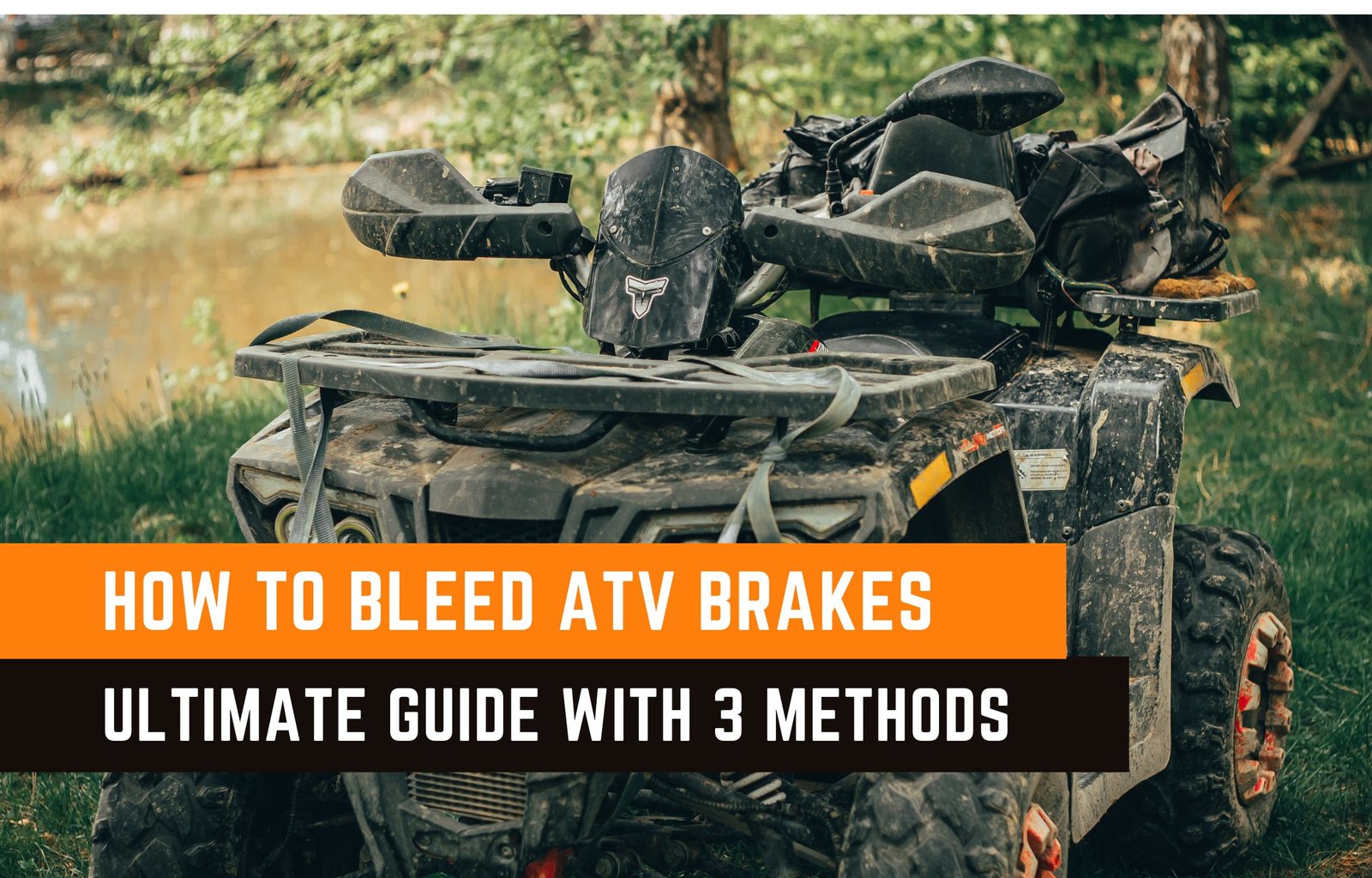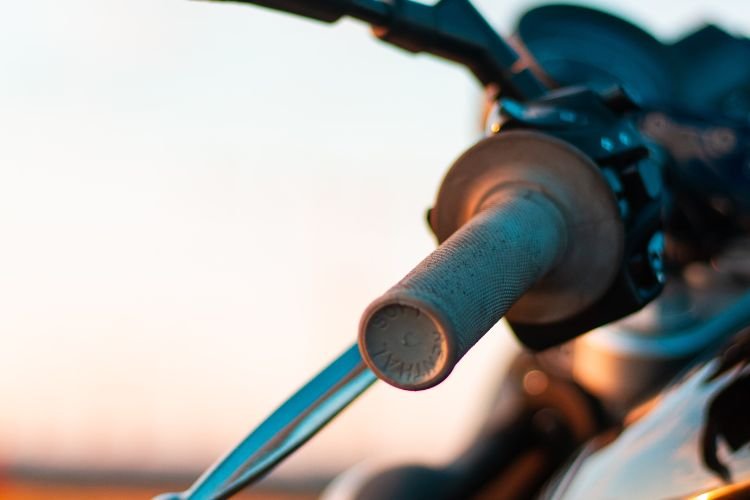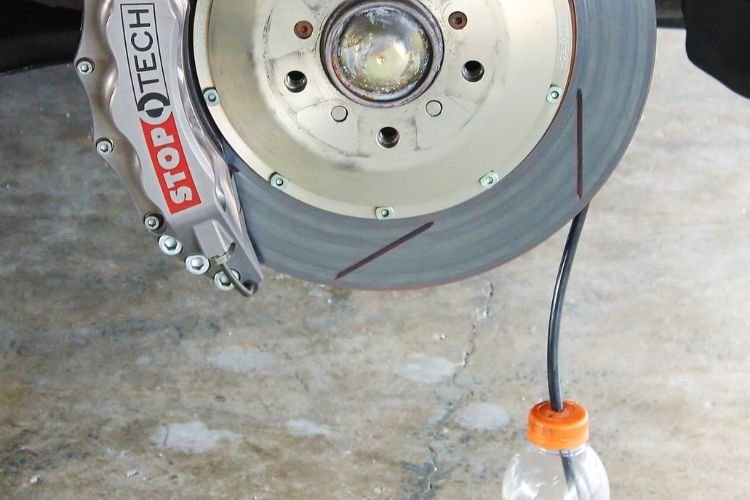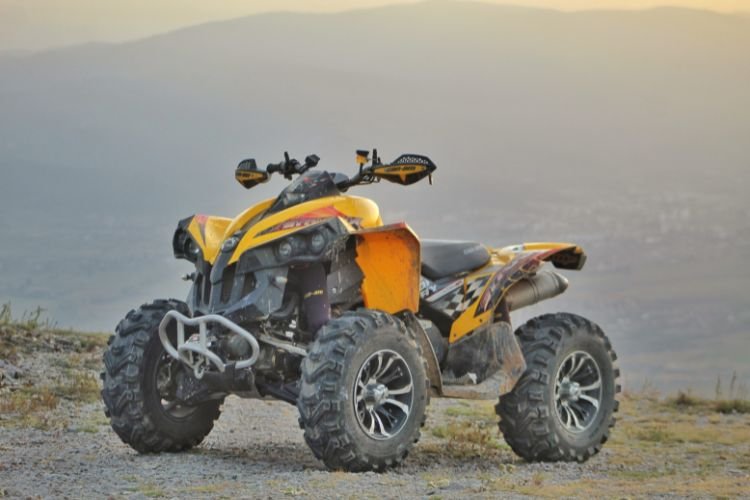Picking the perfect brake pads for your ride has an influence on how safe you are, how well your whip handles, and what you’ll shell out over time. You’ve got a whole menu, from wallet-easy organic pads to fancy ceramic or semi-metallic types. To get why budget brake pads ain't the same as the pricier […]

How To Bleed ATV Brakes? Ultimate Guide With 3 Methods 2023
Bleeding the vehicle's brakes is part of the regular maintenance process. ATVs are not various. While the details procedure of bleeding the brakes might differ depending upon the make as well as the design of your vehicle, the standard steps include draining the brake fluid and then replenishing it with a new lubricating substance to eliminate any type of air bubbles, which might be embedded the system.
As an ATV proprietor, it's a good suggestion to learn a couple of standard mechanical abilities, such as being able to bleed the brakes when required.
This article will certainly take you through what, why, and exactly how to bleed ATV brakes to maintain everything running efficiently as possible so you can kick back and also enjoy your ride.
Table of Contents
What Does Bleeding The Brakes Mean?
Hydraulic brake systems use special brake liquid to move the energy from your hand or foot and to the brake caliper. The fluid is vital for correct brake features.
Inside the caliper, a piston is activated by the brake liquid when stress is applied. The piston will after that push the brake pad versus the brake disc, producing rubbing to stop the bike.
Bleeding the brakes means letting out some of the brake liquid to remove trapped air or to change the brake fluid entirely.
Why Do You Require To Bleed ATV Brakes?
Bleeding ATV brakes eliminate old brake liquid, enabling you to add brand-new brake liquid. It's recommended that you change brake liquid every time you change your brake pads.
You may likewise require to bleed your ATV brakes to get rid of caught air. Air in the cylinder or brake line can make your brake lever feel soft as well as squishy when you push it, seriously impacting braking efficiency.
Bleeding ATV brakes is a relatively easy process that you can do at home with basic tools. There are 3 methods to do it: the manual method, the vacuum method using a brake bleeder device, and also the reverse bleeding method.

Manual Method For Bleeding Brakes
Tool Requirements
- A jack-- to obtain the ATV off the ground
- A wheel nut tool-- preferably a hand tool as various other electrical torque wrenches are also strong for ATVs
- A hex or Phillips little bit that will fit-- you can additionally make use of a little impact driver
- A wrench for the bleeder-- most ATV bleeders are 8mm and a boxed end or a flat nut wrenches will certainly work
- Something to push the brake lever-- this can be a clamp or a helpful person
- Substitute brake liquid-- check the supplier of what type you need, this will also be marked somewhere on the brake storage tank cap.
- Latex gloves-- brake liquid will certainly not be kind to your hands
- Some clear vinyl tubes with one end in a container like an old oil bottle-- use it to accumulate the old brake fluid to make right disposal much easier and also less messy.
1. Make Use Of The Jack To Lift Your ATV
You require to jack your ATV as well as remove the wheels before you can bleed the brakes. It is in theory possible to bleed the brakes without removing the wheels but it is much more difficult. Removing the wheels makes it easier to reach the bleed nipple so it is suggested.
2. Take Off the Cap to the Brake Liquid Reservoir
You require to put new brake liquid in as the old liquid comes out of the system.
The cap on the reservoir is secured with 2 hex screws. Be careful as you remove it as stripping strings is easy to do.
If it has been a while since you last removed the screw, you may need to use an impact driver. Find the correct bit and then use the driver to tap it gently. Hopefully, this will vibrate any corrosion and open the screw up a bit.
Fortunately, the reservoir for the foot pedal is usually a cap twist that you can do by hand.
3. Clean The Cap And Rubber Seal
Brake liquid needs to be maintained unpolluted so any type of exposure to debris, dirt, or even water needs to be kept to a minimum.
4. Top Up The Brake Liquid To The Optimum
You require to ensure that the level of brake fluid in the reservoir is maintained above the minimum during the bleeding procedure. It might be necessary to replenish the reservoir a number of times during the work.
It is best to replace the caps at this phase. You do not require to and you can pump brakes without cover, however, you are substantially more probable to get brake liquid everywhere.
5. Pump The Brake Bar 3 to 4 Times
You will either pump the brake bar or the foot pedal depending on which system you are bleeding. Pump careful if you are risking it and also going cap-free!
You require to keep the lever activated with your hand or by utilizing a spring-loaded clamp. Essentially, you just require to keep it under tension while you are bleeding.
6. Open Up The Bleeder Valve
It is much easier to begin with the bleeder valve outermost away from the fluid tank.
The valves will certainly get on the top of the brake caliper as well as are opened by turning anti-clockwise roughly half a turn. If you have done it properly, the brake fluid needs to begin to permeate out of the bleeder.
When the Brake Bar is at Over Three-quarters of the Total Travel Length, Close the Bleeder Valve.
It is very important not to over-tighten the valve as the threads can easily flake off.
7. Repeat
You require to repeat these actions up until the brake liquid that comes out of the bleeder valve has no air bubbles in it. Be prepared to do this for some time if there is a lot of air in the brake lines.
Repeat these actions for all wheels. Remember that some bikes have simply one brake caliper for the rear brakes-- they will be incorporated into one.
8. Re-fill The Reservoir To The Maximum Mark
You require to fill with brake fluid to the maximum marker. This might get on the evaluation gauge on the side of the storage tank on the within. Some have a gauge at the top that changes color depending on whether the level is low or high.
If you are unsure, get in touch with your maker to learn more.
9. Replace The Cap And Rubber Seal
Make sure that the clean and dry cap and seals are properly installed and also make certain not to tighten the screws way too much.
You can currently replace the wheels as well as you are all done!

Vacuum Bleeding ATV Brakes
While a little much more complicated, this method is still a very easy and also low-cost means to bleed brakes as well as might get out more air.
Tool Requirements
- You require every one of the tools for the previous method
- You will certainly likewise require a hydraulic brake bleeding tool-- these have been available in numerous forms however all work in similarly by drawing down brake liquid and also out through the bleed valve.
Some versions of hydraulic brake bleeders have a hand pump to create a vacuum. There will additionally be a one-way valve to maintain the liquid in one direction. Other models are connected to the compressor to produce the same vacuum result.
1. Repeat The Manual Bleeding Steps Until Pump
Adhere to the Same Steps for the Manual Method Up till the Brakes are Pumped. Stop right here.
Currently, you need to obtain the 8mm wrench so that it is ready to be used.
Link the hydraulic brake fluid pump to the bleeder valve. It is best to comply with the producer's directions right here for the very best results.
2. Turn On The Pump
Activate the pump and after that transform the bleeder valve into a half turn. Air bubbles need to be gotten with the fluid and splutter into the container.
You need to pay attention to the level in the reservoir as the pump can drain it immediately if you are not paying attention.
If your level begins to run low, you require to tighten up the valve again as well as switch off your pump. Put extra fluid into the tank, switch the pump back on and also loosen the bleeder valve.
3. Continue Pumping The Brake Fluid
Continue pumping until the brake fluid is streaming in a consistent stream-- no spluttering as this means there are air bubbles-- and also it is clear or slightly amber.
Tighten the bleeder valve and afterward turn off the pumping tool.
4. Repeat
Repeat this process for all of the brakes you wish to bleed.
When you are finished, ensure that you top up the brake liquid reservoirs so that the liquid sits at the maximum line.

Reverse Bleed ATV Brakes
If you don't want to buy an expensive bleeder venting tool, another quick way to remove trapped air and old oil is to reverse bleeding.
Reverse bleeding works in the opposite way to normal brake bleeding. Instead of pushing the old brake fluid out of the reservoir and draining it through the bleed valve, new brake fluid is added through the bleed valve and the old brake fluid is sucked out of the reservoir.
Not only is reverse bleeding easier and faster (especially because you don't need a pump brake lever), it can sometimes be better at removing trapped air pockets.
You'll need 2 syringes, a 5/16 inch clear tube, a Phillips screwdriver, and an 8mm wrench. Here's the step-by-step process.
- Open up the tank cap and make use of one of the syringes to suck out some of the old brake liquid. Do not allow the level to drop below the minimum.
- Load the various other syringe with brand-new brake fluid as well as attach the clear tube on its end.
- Open the bleed valve cap as well as put the clear tube. Hold the syringe and the connected tube vertically to prevent air from entering. Touch the tube to get rid of any type of caught air bubbles.
- Still holding the syringe upright, position the 8mm wrench on the bleed valve and also turn it anticlockwise half a turn. Currently, gently push the syringe to press new brake liquid with the valve.
- Quit after a few seconds to ensure the storage tank does not overflow. If there's someone else around, ask them to draw out more brake fluid from the storage tank. If you are alone, hang the syringe from something like a band or cord to maintain it upright, then go draw brake fluid from the reservoir.
- Open the bleed valve and push more brake liquid in. After a few seconds, close the valve as well as attract more brake fluid from the tank.
- Repeat this procedure until the liquid in the reservoir is clear or somewhat brownish-yellow. That suggests that the brake system now includes only brand-new brake fluid. Examine your brakes to make sure they feel firm and tight.
- When you are done, close whatever up the way it was and also dispose of the old brake liquid someplace safe. Repeat for any other brake line.

When To Bleed Brakes
There are 2 reasons to Bleed your ATV brakes:
- To eliminate air in the brake lines
- To replace old or bad brake liquid
1. Eliminate Air In The Brake Lines
The most minute air bubble in the brake system can create problems in features and also make the brake feel squishy or soft. This is a huge safety worry so every one of the air needs to be gotten off the system immediately. You need to bleed your brakes.
Air will not enter the brake system through normal use. You must locate the problem and rectify it. It is best to do this before you bleed your brakes or you will have to bleed once again.
Air can get in the brake system if it is not shut. Seek any type of loosened brake lines and also repair them per the maker's directions.
Changing or taking apart any kind of component connected to the brake line may enable air to enter the system. You might find that you need to bleed your brakes after service, particularly if the brake caliper is taken off.
2. Replace Old Or Bad Brake Liquid
As brake fluid is hygroscopic, it will take in water throughout its time in your ATV's brake system. Direct exposure to warmth will certainly additionally create the brake fluid to break down, minimizing its efficiency as well as restricting the power of your brakes. Any type of fluid that is near the brake caliper will certainly be most influenced by heat degeneration due to the high friction near the disc when damaged.
Healthy or new, good-quality brake liquid will be someplace between completely clear and transparent with a color of brownish-yellow. Any brake fluid that looks a lot more like cola or coffee has been waiting on a replacement for a while. Replace it asap!
As bad brake fluid does adversely impact the working of your brakes, it is very important to change it rather on a regular basis. Generally of thumb, you ought to intend to replace your brake fluid every single time you transform your brake pads.

Conclusion
Bleeding the brakes on an ATV is really important to maintain them functioning appropriately.
You can use the manual method to bleed your ATV brakes to easily change the brake fluid or eliminate air bubbles.
If you have a great deal of air in your liquid hereafter process, you might need to attempt once again using a vacuum pump to remove the brake liquid faster as well as with greater pressure. This will drag out more air from the brake system.
How To Bleed Motorcycle Brakes? Best Guide 2022

Rodney L is a technical writer and product consultant with over a decade of experience in the motor industry. Rodney is a fan of performance machines that run fast and loud and an expert in all things custom. His numerous articles and write-ups are available at our knowledge base. Whether it’s something wrong with your motorcycle or you are building a custom bike, you can trust Rodney’s experience.
E-bikes have transformed into more than just gadgets to help you get around. Now, they're speed demons that can go toe-to-toe with motorbikes. It’s 2025, and these speedy machines have gotten a huge boost from better motors, more powerful batteries, and sleek designs that cut through the air like a knife. Let’s dive into the […]
Many riders who aren't so tall or ladies just starting to ride bikes need to pick out the best Motorcycles for Short Riders and Women. They gotta look for three key things: a seat that's not too high up, a bike that's not too heavy, and something that looks good enough to give them confidence. […]
As we accelerate into 2025, motorbikes are getting a serious tech upgrade. They’re all about safer rides and more fun on the road. Even if you’re a pro or just starting, kitting out your two-wheeler with cool tech stuff is a game-changer. Check out these ten top motorcycle gadgets each motorcyclist will want in 2025. […]
Getting around the city every day can be super annoying. You've got traffic like molasses nowhere to park, fuel prices through the roof, and buses stuffed like sardine cans make heading to the office a real pain. For loads of folks, getting a motorcycle is a pretty slick move—they’re nimble, cost-effective, and perfect for squeezing […]
Rider safety demands motorcycle helmets. Yet, riders still clash over picking full-face vs open-face helmets. Full-face ones take the win for protecting in crashes, but open-face models charm folks who want cool looks better air, and that old-school vibe. This guide dives into the latest research, technological advancements, and real-world insights to help you decide […]

